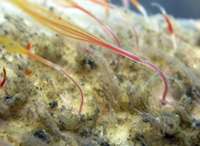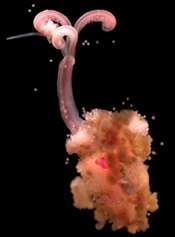Oily whale bones puzzle solved

The puzzle of why some oily whale bones make great habitats for weird and wonderful deep sea creatures has been solved by Natural History Museum scientists this month.
Certain whale bones have much higher concentrations of oil than others, and when a carcass sinks to the ocean seabed, it becomes a unique habitat for scavenging seabed creatures like bone-eating worms. These hotspots of biological diversity can last for decades.
Museum researcher Nicholas Higgs studied forgotten data in the Museum library, collected more than 50 years ago during the times of industrial whaling.
He analysed measurements of oil content in different bones from the sperm whale, grey whale, humpback whale, fin whale and the sei whale.
‘When I looked at the data I realised that I had seen this pattern before: all of the oiliest bones seemed to be the ones that lasted the longest on the seabed,’ says Higgs.
‘This answered several outstanding puzzles, such as why some bones have different animals living on them and why some bones appear to degrade faster than others.’
For example, Higgs found that the bones of the upper back have 40% less oil than those of the lower back. Those of the upper back are often the first to degrade.
Whale-fall communities
Whales are unique among vertebrates for the enormous oil reserves held in their soft tissue and bone.
A dead whale that has fallen to the seabed quickly attracts passing opportunists and scavengers and becomes an oasis of food in the hostile deep sea environment.
Many of these whale-fall creatures have only recently been discovered, such as the great-named bone-eating snot worm, Osedax mucofloris.
And some are record breaking, like the Japanese giant spider crab, which is the largest crab in the world with a leg span up to 4m.
‘Knowing how these islands of life function and evolve is important for understanding the surprising diversity of life that we find in the deep sea,’ says Higgs.
Fossil record
This new research also helps explain why certain whale bones are more likely to become fossilised than others.

‘The oiliest bones seemed to be the ones that appear in the fossil record,’ says Higgs. ‘This indicates that the oil protects the bones from the micro-organisms that destroy them.’
Clues in the fossil record reveal humans have used whale oil for 1000s of years, and this research may help scientists get new insights into how early humans used bones as fuel.
The paper Bones as biofuel: a review of whale bone composition with implications for deep-sea biology and palaeoanthropology is published in the Proceedings of the Royal Society, Biological Sciences.
More information: rspb.royalsocietypublishing.org/
Provided by American Museum of Natural History

















